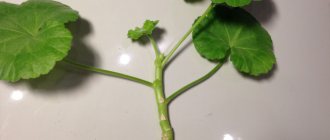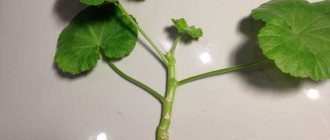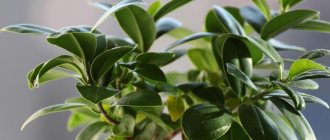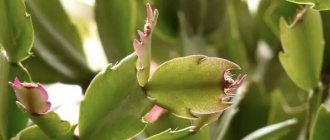Propagating ficus from shoots is a good opportunity to update a plant familiar to the interior and get new specimens for the home flower garden. This is a fun and uncomplicated event that takes little time and does not require significant financial investments.
Pruning the shoots will also benefit the mother plant, which, as it matures, loses its decorative value due to excessive elongation of the stem. We will tell you in this article how to properly take a shoot from a ficus, root it and grow a healthy plant.
Selection of timing and shoots for cuttings
It is important to carry out any interventions in ficus tissue taking into account its biological characteristics. This is the main condition on which the restoration of the mother plant and the degree of rooting of the cuttings depend. The quality of planting material and correct planting determine the resistance to disease and temperature conditions of the new plant.
Ficus transplant at home
The event is planned for early spring, when the intensity of sunlight increases. During this period, increased metabolism and formation of phytohormones occur in the ficus tissues, which stimulate the growth of new roots. After planting the ficus in March or early April, the plant will have enough time to strengthen its roots until autumn.
An important condition for the rooting of shoots is the complete ripening of the shoots. This process can be stimulated artificially. To do this, 15 days before cuttings, stop watering the ficus and moisten the plant with an aqueous solution of charcoal (20g/10l).
Depending on their location, ficus shoots have different properties. The closer the shoot is to the growth point, the better the stage changes occur in them. This means that planting material from the top of the plant will take root, develop and bloom faster.
Therefore, for rooting, it is not uncommon to choose the apical shoot, or, in extreme cases, shoots from the middle part of the ficus. A prerequisite is a healthy leaf bud on the top of the cutting.
Ways to stimulate rapid growth and root formation
After planting the rooted shoot in a pot, roots are formed in the callus tissue of the plants. This happens through mechanical damage to the stem, as a result of which the root system of the ficus is formed. To speed up this process, you can make a few small cuts on the stem yourself before planting the shoot.
Better growth of ficus is facilitated by the use of special chemical fertilizers. They will improve the formation of the ficus root system. Treatment with growth stimulants is carried out as follows: the shoots are soaked in the prepared solution before planting, or the cut of the cutting is treated with a preparation that comes in powder form.
Preparation of the process
To cut the shoot you will need a sharp garden knife and activated carbon powder. The procedure is not carried out with scissors or a blunt instrument, especially since the flower shoot should not be broken off. This greatly disrupts the structure of the cambium, and as a result, the nutrition of the plant.
How to root a flower shoot without roots? The ficus shoot should be 12-17 cm in length with 2-3 leaf internodes. How to take a shoot from a ficus? The cut is made 0.5 cm below the internode at a slope of 45°C relative to the stem. After this, the wounds of the mother plant are treated with activated carbon.
Ficus grown from a shoot
Cuttings of the cuttings are washed in running water. In this way, the milky juice is washed off, which can subsequently create a dense crust and clog the stomata on the cutting. This greatly interferes with root formation.
For ficuses with large leaves (rubber, lyre-shaped), they are cut in half and rolled into tubes, tied with a soft cord. This will help avoid excessive evaporation of moisture and relieve the plant of the burden of feeding a large number of cells.
In small-leaved plant species, only the lower leaves are trimmed. Leaves play an important role during rooting of cuttings. They supply the plant with hormonal, energy and plastic substances that are formed during the process of photosynthesis. Therefore, you should not greatly reduce the green mass.
After this, the cuttings are kept in warm, settled water for 2 hours and dried until a thin film forms on the sections. During wilting, excess moisture evaporates, which significantly reduces the risk of rot.
To stimulate the rapid formation of roots, cross-shaped cuts are made with a knife on the cutting. This increases the wound surface on which callus tissue will form - the basis for the formation of new roots.
Leaf propagation
To grow some varieties of ficus, it is enough to simply root a branch with a leaf. This method is often called heel-leaf propagation.
On a branch of a mature, large plant, a section with a leaf is cut out. The cuts are made at the node itself or cut directly along it. The upper cut is made horizontally, the lower one at an angle of 45°.
The cut is treated in the same way as cuttings: the juice is removed, dried, and treated with root stimulants. Then they are buried in the prepared soil mixture up to the very leaf, rolled up and fixed in the form of a tube. Further care of the leaf is similar to caring for the cutting.
Planting a shoot in the substrate
How to plant a ficus sprout? To root the cutting, you need to prepare a container 10 cm high. It is disinfected with a 3% formaldehyde solution. It is better to mix the substrate a few days before planting the cuttings. During this time, it is structured and saturated with moisture.
To do this, mix the components:
- peat 40%;
- river sand 40%;
- vermiculite 20%.
A ficus shoot that has a root
After this, pour with boiling water or a 1% solution of potassium permanganate.
Before planting the cuttings, the sections are treated with “Kornevin” (growth stimulant) or crushed charcoal. Planting material is buried to the level of the lower node in a moist substrate.
How to grow a ficus shoot? For rooting, ficus cuttings require high humidity of at least 85% and high temperature +28°- +30°C. This can only be achieved in a mini-greenhouse.
To do this, you will need a transparent plastic container of suitable volume, in which you need to make 8-10 small holes with a needle. Cover the cutting with it and place it in a well-lit place.
The ideal option is south-facing window sills with radiators located below, which will provide the required temperature.
During the rooting period, the greenhouse is ventilated twice a day for 15 minutes, morning and evening. Complete formation of ficus roots occurs on average after 30 days. This can be judged by the appearance of new leaves. During this period, ventilation is done every day, gradually increasing the time and accustoming the plant to indoor conditions.
Step-by-step instruction
The best time to plant a ficus shoot is spring; summer sunny weather is better for rooting and subsequent adaptation of the plant. If the shoot is planted in the fall, the young plant will not have time to prepare for winter frosts and may simply die.
Before planting a ficus benjamina shoot, you need to select a cutting 10 centimeters long, which has previously been rooted into the ground. Further, all actions occur in several stages:
- Prepare all the necessary materials described earlier.
- Place drainage at the bottom of the pot to avoid excess moisture in the soil, since a large amount of water can lead to rotting of the roots.
- Fill the pot with the prepared earthen mixture, then make a small depression in the center, about one and a half to two centimeters high.
- Place the rooted cuttings in this hole and sprinkle a little with the mixture, then water generously.
Now the ficus can be placed on a windowsill or a special flower shelf, and the plant also needs special care to keep it healthy.
Features of rooting cuttings in water
For this event you will need a glass container with a dark tint. This will limit the access of sunlight to moisture, which promotes the development of algae (water blooms). If the container is transparent, it is wrapped in thick paper.
Ficus shoot
For rooting ficus, use filtered or boiled water, slightly warmer than room temperature. A piece of charcoal or activated carbon is added to it. It is an excellent antiseptic and stimulator of root formation.
Only the stem of the cutting is immersed in water. Water getting on the leaves leads to rapid rotting. To maintain the plant at the required level, you can cut a circle of foam with a hole for the stem in the middle. It is placed on the surface of the container and the end of the cutting is lowered into the water through the hole.
A mini-greenhouse with periodic ventilation is also equipped for the plant. Add water as it evaporates. After 5-10 days, the formation of white growths - callus tissue - can be observed on the cut of the cutting. After the roots reach 2-3 cm, the cuttings are transplanted to a permanent place of development.
It is not recommended to keep the plant in water longer. Ficus roots develop slightly differently in water than in soil. They are covered with fluffy root hairs, which, when placed in a substrate (in a drier environment), gradually begin to die off. Therefore, it is important to transplant the cuttings before the roots develop to a large volume.
How to properly care for ficus trees depending on the type
Kinky
Kinky is a miniature variety of Benjamin.
Care:
- The plant loves diffused light, so it is better to place the pot on the east or west side.
- The air where ficus grows should not be too dry.
- Watering is plentiful, but moderate.
Kinki - a dwarf variety of Benjamin
Melanie
Melanie is a type of rubber ficus, considered the most popular and unpretentious ficus.
Care:
- Needs periodic feeding and timely replanting.
- The light should be diffused, but not bright.
- Water immediately after the top layer of soil dries.
Melanie is the most unpretentious variety
Lyre-shaped ficus
The plant got its name because the dark green large leaves resemble a lyre or violin.
Care:
- Requires a favorable microclimate close to natural.
- Loves high air humidity and does not tolerate direct sunlight.
- The variety is sensitive to changes in temperature.
Lyre-shaped variety - the original shape of the foliage made this variety very popular
Microcarpa
The variety got its name due to the small size of the fruits. At home it is grown as a bonsai.
Care:
- The plant does not tolerate direct sunlight and requires periodic spraying.
- Water abundantly, especially in winter, since drying out of the earthen coma leads to the death of the plant.
Microcarpa is an ideal variety for growing bonsai
Natasha
Natasha is a dwarf variety of Benjamin. The variety comes with plain and variegated leaves.
Care:
- Warm, bright room without drafts.
- Watering is regular and moderate.
- Air humidity not less than 60%.
- Transplantation - once every 5 years.
Unpretentious variety Natasha
Robusta
One of the earliest and most widespread varieties of ficus rubber. The name of the variety comes from the English word robust, which means strong, healthy and strong.
Care:
- Air temperature – up to +22−25°C.
- A bright or shaded place.
- Moderate watering with warm, settled water.
- Air humidity is above 50%.
Robusta is the most famous variety of rubber ficus
Elastica
Ficus of this variety is considered a tree of prosperity. It protects comfort in the home and maintains relationships in the family.
Care:
- Can grow in both sun and partial shade.
- Temperatures in summer are up to +30°C, in winter – up to -15−20°C.
- Stable and balanced watering.
- Feeding - once a month in spring and once every 14 days in summer.
Ficus elastica - tree of well-being
Ali
The variety is unpretentious and looks unusual. The difference from other ficuses is the size and shape of the leaf. This is a narrow-leaved plant with drooping shoots.
Care:
- Does not tolerate sudden temperature changes and soil hypothermia.
- Humidity should be moderate. On hot days, spray and warm shower.
- Watering is abundant and moderate.
- Feeding - once every 10 days.
The narrow-leaved variety Ali is not only unpretentious, but also very beautiful
Ginseng
Ginseng is often grown in bonsai form due to its trunk, which looks like tied roots. Dark olive leaves form a neat crown.
Care:
- Grows well in partial shade.
- The optimal temperature for development is up to +16−22°C.
- Does not tolerate soil drying out.
Ideal for growing bonsai
Catalog of indoor flowers with photos and their names. In a special publication on our portal we will talk in detail about indoor flowers. You will learn the types of indoor flowers, about fruit indoor flowers and get acquainted with the photo gallery.
Transplanting a rooted ficus
When choosing a pot for a ficus, you focus on the size of the roots that will develop in the first year. If the volume is too large, water will stagnate in areas of the substrate undeveloped by the plant roots and pathogenic microflora will develop. Therefore, the diameter of the pot should be 2 times smaller than the ficus crown.
A drainage layer of expanded clay is laid at the bottom of the pot, which occupies 15% of the total area. Young ficuses are more sensitive to the quality of the substrate; for them, mix in equal parts:
- humus;
- peat;
- washed river sand.
For greater looseness, add a handful of fine expanded clay or charcoal to the components, which will absorb excessive moisture. The finished substrate is disinfected with a solution of potassium permanganate or boiling water.
Adult ficus for home decoration
The pot is filled 2/3 with the substrate and the ficus roots are placed in it, gradually sprinkling it.
At the same time, the formation of voids is controlled, which can subsequently lead to rotting. The soil is compacted and watered with water at room temperature.
After planting the cutting in the ground, it is kept for 2-3 days in a shaded room. This is necessary for the roots to adapt to the substrate. After this, a permanent location is chosen based on the species requirements.
Subsequent ficus transplants up to 4 years are done annually using the transshipment method. Older plants are replanted every 2-3 years. In the intervals between transplants, a layer of substrate up to 5 cm is replaced with more nutritious soil.
Expert opinion
Yulia Yurievna
I have a large garden and vegetable garden, several greenhouses. I love modern methods of cultivating plants and mulching the soil, and I share my experience.
Ask a Question
How to choose a pot for a plant
The choice of pot is one of the important factors, since if you choose the wrong shape and volume, in particular, the ficus will not be able to fully develop. Therefore, before planting a ficus shoot, it is recommended to make a choice based on the size and degree of development of the roots. The container should not be too large; to plant a shoot, it is better to take a pot with a diameter of no more than 10 centimeters, and you need to make sure that there are drainage holes at the bottom. If there are none, then you need to make them yourself. The height of the pot should not be small; the roots should be at least 2 centimeters higher from the walls and bottom of the vessel.
Tools
Before taking cuttings, we need to find out what tools we need. Prepare everything you need in advance so that you are not distracted by anything while working.
- Knife. Remember: cut off the shoots exclusively with a sharply sharpened knife. There is no need to tear off a ficus shoot with your hands or try to cut it with scissors, as this will only harm the flower. A very important point: be sure to disinfect the knife you will use before the procedure.
- Container with warm water. This is where we place the ficus shoots immediately after we cut them.
- Dark glass vessel. After all the procedures, you need to place the cutting there until it takes root.
Useful tips for care after pruning
If pruning is done correctly, the plant looks neat and gives the impression that it has not been touched at all. To prevent the ficus from getting sick, it is necessary to periodically inspect the plant for bacterial infection and follow some recommendations:
ficus after cropping photo
- A freshly pruned plant should not be sprayed; moisture that gets on the cuts can provoke the development of the disease;
- do not place the pot with ficus in a draft or in a cold room, the temperature should not be lower than room temperature;
- do not over-moisten the soil;
- Be sure to feed the plant; in the spring this can be done immediately after pruning.
If you follow all the rules and recommendations, after pruning the ficus will form a crown of the desired shape, but in order for this shape to be maintained permanently, pruning must be carried out regularly, with an interval of 2 months.
Ficus is a plant loved by many gardeners, which has one feature: it only grows upward. Specimens growing in natural conditions can reach a height of forty meters. In apartment walls, owners often have a question: how to prune a ficus tree so as not to harm it. Some novice gardeners argue about how useful such manipulations are for the plant. Experts say that a procedure such as ficus transplantation and root pruning is an integral part of caring for this species.
It allows not only to form a tree of an original shape, but also to rejuvenate the crop.
Formation
In order for Ficus Benjamin to grow as a tree with a rounded crown, you need to cut off the leaves and shoots so that a fairly long trunk remains.
Pruning is best done during the dormant period. If this is done during active growth, there is a risk of weakening the plant. The ideal period is from December to March.
The cutting tool should be pre-treated with alcohol to prevent bacteria from entering the cut. The plant needs to be watered and the leaves need to be washed. Thin shoots are cut straight, and thick shoots are cut obliquely. After the procedure, you need to remove the juice from the cut with a napkin and treat the area with crushed activated carbon.
This plant lends itself well to the formation of a figured or woven trunk. To do this, plant two ficus trees at once, twisting their trunks together and fixing the structure at the base of the crown. When the plant gets stronger and the trunks become coarser, the retainer is removed.











